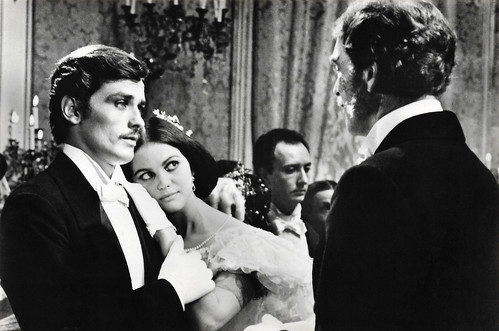
Czech postcard by UPTF / Pressfoto, Praha (Prague), no. C 198, 1965. Photo: G.B. Poletto. Alain Delon, Claudia Cardinale, and Burt Lancaster in Il Gattopardo/The Leopard (Luchino Visconti, 1963).

Czech postcard by UPTF / Pressfoto, Praha (Prague), no. C 199, 1965. Photo: G.B. Poletto. Alain Delon in Il Gattopardo/The Leopard (Luchino Visconti, 1963).

Czech postcard by UPTF / Pressfoto, Praha (Prague), no. C 200, 1965. Photo: G.B. Poletto. Alain Delon and Claudia Cardinale in Il Gattopardo/The Leopard (Luchino Visconti, 1963).

American publicity photo. Photo: G.B. Poletto / Titanus / 20th Century Fox, used in Dutch cinemas (a Dutch censorship stamp is visible in the upper-right corner). Alain Delon in Il Gattopardo/The Leopard (Luchino Visconti, 1963).

American publicity photo. Photo: G.B. Poletto / Titanus / 20th Century Fox, used in Dutch cinemas (a Dutch censorship stamp is visible in the upper-right corner). Alain Delon in Il Gattopardo/The Leopard (Luchino Visconti, 1963). The man seen in the back may be Giuliano Gemma.
A ticket of admittance to the high-class soirées of the nobility
Il Gattopardo/The Leopard (1963) is based on Giuseppe Tomasi di Lampedusa's 1958 bestseller 'Il Gattopardo' about an aristocratic Sicilian family's adjustment to a changing way of life during the Risorgimento. After the premiere, the long epic received mixed reviews but it is now seen as one of the greatest classics of Italian cinema.
In Sicily in 1860, Don Fabrizio Corbera, Prince of Salina (Burt Lancaster) enjoys the customary comforts and privileges of an ancient and noble name. War has broken out between the armies of Francis II of the Two Sicilies and the insurgent volunteer redshirts of Giuseppe Garibaldi. Among the rebels is the Prince's remarkably handsome and dashing nephew, Tancredi (Alain Delon), with whose romantic politics the Prince shares some whimsical sympathy. Moved by the uprising, the Prince departs for nearby Palermo. Garibaldi's army conquers the city and Sicily from the Bourbons. The Prince muses upon the inevitability of change, with the middle class displacing the hereditary ruling class while on the surface everything remains the same.
Refusing to bend to the tide of necessity, the Prince departs for his summer palace at Donnafugata. A new national assembly has called a plebiscite which the nationalists win 512-0, thanks to the corruption of the town's leading citizen, Don Calogero Sedara (Paolo Stoppa), who sees his daughter, the exquisitely beautiful Angelica (Claudia Cardinale), as a ticket of admittance to the high-class soirées of the nobility. Bringing her with him to the villa of the Salinas, he watches as both the Prince and Tancredi fall abjectly in love with her. Realising his chance, he effectively pimps his daughter to the aristocracy, and Tancredi offers his hand. The Prince sees the wisdom of the match because he knows his nephew's vaulting ambition and his need for ready cash, which Angelica's father, greedy for familial prestige, will happily make available. With the mutual blessing of the Prince of Salina and Don Calogero, Tancredi and Angelica become engaged.
A visitor from the constituent assembly comes to the villa. He begs the great scholar and nobleman to join the senate and help direct the ship of state; he hopes that the Prince's great compassion and wisdom will help alleviate the poverty and ignorance to be seen everywhere on the streets of Sicily. However, the Prince demurs and refuses this invitation, claiming that Sicily prefers its sleep to the agitations of modernity because its people are proud of who they are. He sees a future when the leopards and the lions, along with the sheep and the jackals, will all live according to the same law, but he does not want to be a part of this democratic vision. He notes that Tancredi has shifted allegiances from the insurgent Garibaldi to the king's army, and wistfully recognises that his nephew is the kind of opportunist and time-server who will flourish in the new Italy.
A great ball is held at the villa of a neighbouring Prince, and the Salinas and Tancredi attend. Afflicted by a combination of melancholia, the ridiculousness of the nouveau riche, and age, the Prince wanders forlornly from chamber to chamber, increasingly disaffected by the entire edifice of the society he so gallantly represents – until Angelica approaches and asks him to dance. Stirred and momentarily released from his cares, the Prince accepts, and once more he resembles the elegant and dashing figure of his past. Disenchanted, he leaves the ball alone, asks Tancredi to arrange a carriage for his family, and walks with a heavy heart to a dark alley that symbolises Italy's inordinate and fading past, which he inhabits.
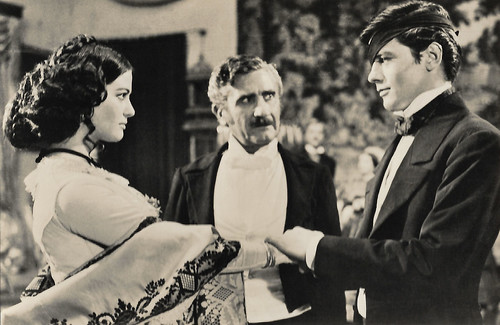
Small Czech collectors card by Pressfoto, Praha (Prague), 1965, no. S 101/6. Photo: G.B. Poletto. Claudia Cardinale, Paolo Stoppa, and Alain Delon in Il Gattopardo/The Leopard (Luchino Visconti, 1963).
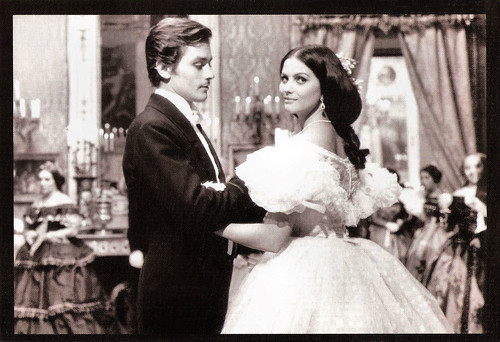
Vintage card. Photo: G.B. Poletto. Alain Delon and Claudia Cardinale in Il Gattopardo/The Leopard (Luchino Visconti, 1963).
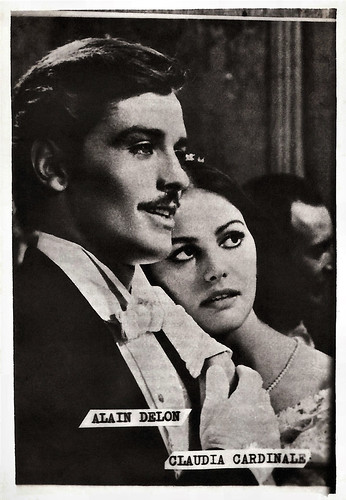
Small Romanian collectors card. Photo: G.B. Poletto. Alain Delon and Claudia Cardinale in Il Gattopardo/The Leopard (Luchino Visconti, 1963).
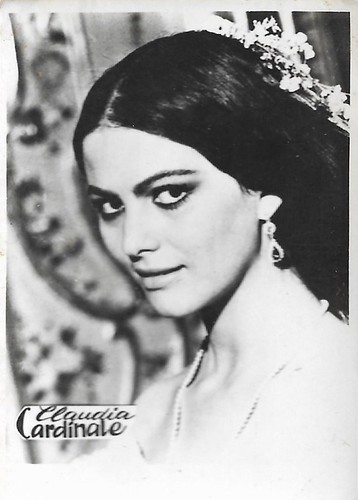
Small Romanian collectors card. Photo: G.B. Poletto. Claudia Cardinale in Il Gattopardo/The Leopard (Luchino Visconti, 1963).
One of the most spectacular sequences in film history
For the leading role in Il Gattopardo/The Leopard, the producers chose Hollywood star Burt Lancaster without consulting director Luchino Visconti. This insulted the director and caused tension on the set. However, Visconti and Lancaster ended up working well together, and their resulting friendship lasted the rest of their lives.
The epic cost production company Titanus $5 million. Visconti's first cut was 205 minutes long and was shortened to 195 minutes for its 1963 Cannes Film Festival premiere, where it won the Golden Palm for best picture. Visconti then cut the film further to 185 minutes for its official release and considered this version to be his preferred one. The picture was subsequently distributed by 20th Century Fox in a poorly dubbed, 165-min. English-language version, using an inferior colour process.
The film was a box office hit in Italy and other European countries, but international critics were mixed about the film. The restored Italian-language version, supervised by cinematographer Giuseppe Rotunno, appeared in 1990. Through the years, more and more people started to love the film. Martin Scorsese considers the film to be one of the greatest ever made, and in 2010, his Film Heritage Foundation restored the film to its original splendour.
Yuri German at AllMovie: "The closing section, an almost hour-long ball, is often cited as one of the most spectacular sequences in film history. Burt Lancaster is magnificent in the first of his patriarchal roles, and the rest of the cast, especially Delon and Cardinale, become almost perfect incarnations of the novel's characters. Filmed in glorious Techniscope and rich in period detail, the film is a remarkable cinematic achievement in all departments."
Ivo Blom in 'Visconti and the Visual Arts': "In Il Gattopardo, painting performs an important part in the sets of the film. A famous example is the painting Don Fabrizio sees when entering a library during the ball to escape the crowd, a painting which reminds him of his own nearing death. A memento mori, so to say. The painting is a copy of Jean-Baptiste Greuze’s moralistic and sentimental work 'Le mauvais fils puni' (1778), today one of the masterpieces of the Louvre; a prodigal son returns too late, his father has died. (...)
Note also in Il Gattopardo the decaying old paintings in the attics of the palace, which Tancredi and Angelica see. They are not only indicators of the location but also comment on the protagonists. Angelica’s old rose dress, though a bit old-fashioned for the period, stands out against the faded enormous battle scene she sees. Lampedusa already indicates it in the novel as Arturo Corbera at the Battle of Antioch, a battle scene between Crusaders and Muslims, but the painting in the film — an imitation made by Mario Brondi — is clearly a variation on Rubens’ 'Battle of the Amazons'. The painting is emblematical of the situation. Old glories of the aristocracy fade away, and the freshness and sensuality of Angelica is what counts."
Roger Ebert on his website: "Finally the prince dances with Angelica. Watch them as they dance, each aware of the other in a way simultaneously sexual and political. Watch how they hold their heads. How they look without seeing. How they are seen and know they are seen. And sense that, for the prince, his dance is an acknowledgement of mortality. He could have had this woman, would have known what to do with her, would have made her his wife and the mother of his children and heard her cries of passion, if not for the accident of 25 years or so that slipped in between them. But he knows that, and she knows that. And yet of course, if they were the same age, he would not have married her, because he is Prince Don Fabrizio and she is the mayor's daughter. That Visconti can convey all of that in a ballroom scene is miraculous and emotionally devastating, and it is what his movie is about."

Romanian minicard. Photo: G.B. Poletto. Alain Delon as Tancredi Falconieri in Il Gattopardo/The Leopard, (Luchino Visconti, 1963).

Vintage film still by G.B. Poletto. Mario Girotti as Count Cavriaghi and Lucilla Morlacchi as Concetta in Il Gattopardo (Luchino Visconti, 1963).
Source: Film Heritage Foundation (YouTube). A clip from Il Gattopardo/The Leopard, restored in association with Cineteca di Bologna, L'Immagine Ritrovata, The Film Foundation, Pathé, Fondation Jérôme Seydoux-Pathé, Twentieth Century Fox and Centro Sperimentale di Cinematografia-Cineteca Nazionale - restoration funded by Gucci and the Film Foundation.
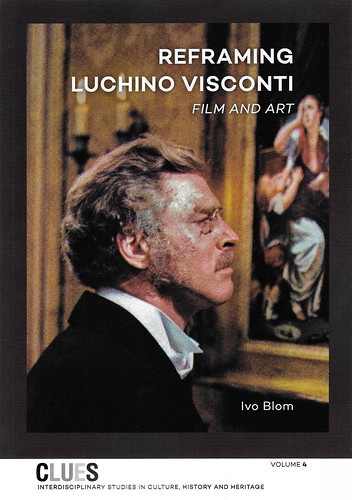
Cover of Ivo Blom's study 'Reframing Luchino Visconti'. Photo: Burt Lancaster in Il Gattopardo/The Leopard (Luchino Visconti, 1963).
Sources: Ivo Blom (Visconti and the Visual Arts), Roger Ebert, Yuri German (AllMovie), Julian Sanction (Vanity Fair), Sorrisi (Italian), Wikipedia, and IMDb.
2 comments:
One of my all time favorite Visconti films---I stumbled upon it many years ago in the middle of the night---and ended up staying up all night to watch it---which I regretted since I had to work that day! But seriously, it is an excellent film, this is an excellent post, and I have linked back to it from my blog. Happy New Year guys!
Thanks, Maria,
We totally agree about Il Gattopardo.
And Happy New Year to you and to Croyton too!
Greetings from Amsterdam,
Paul
Post a Comment